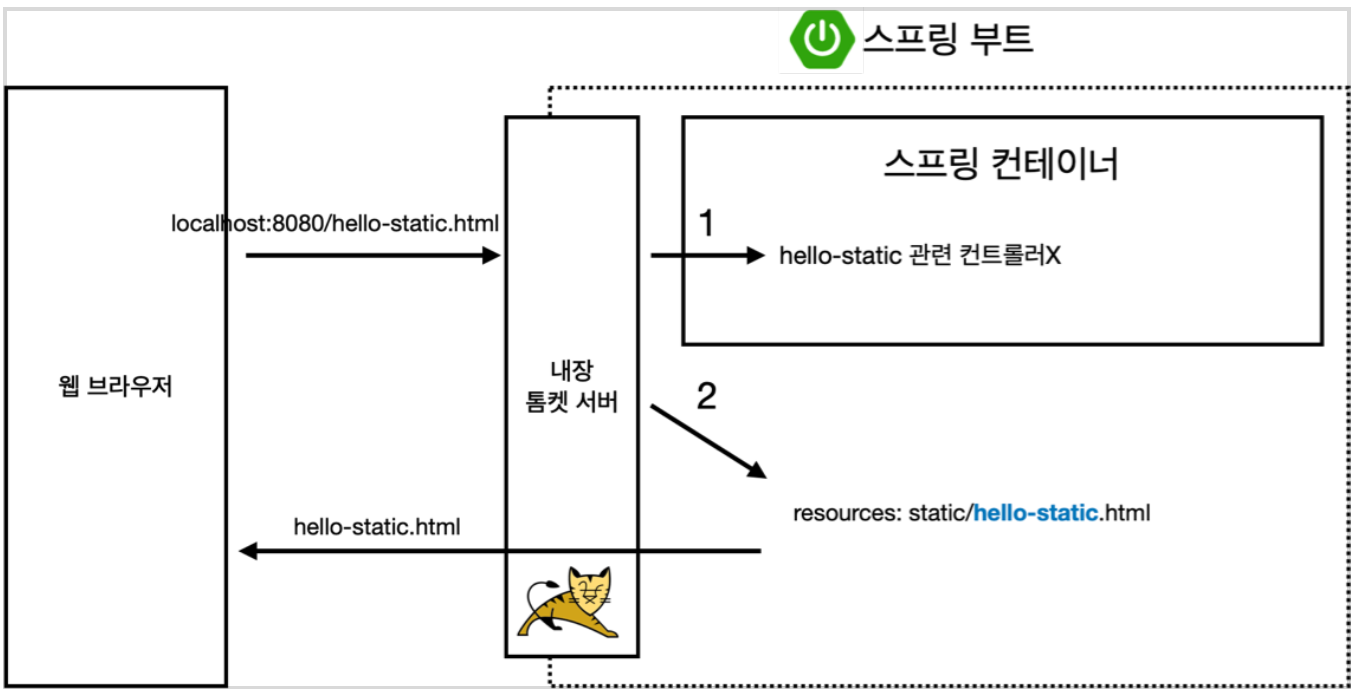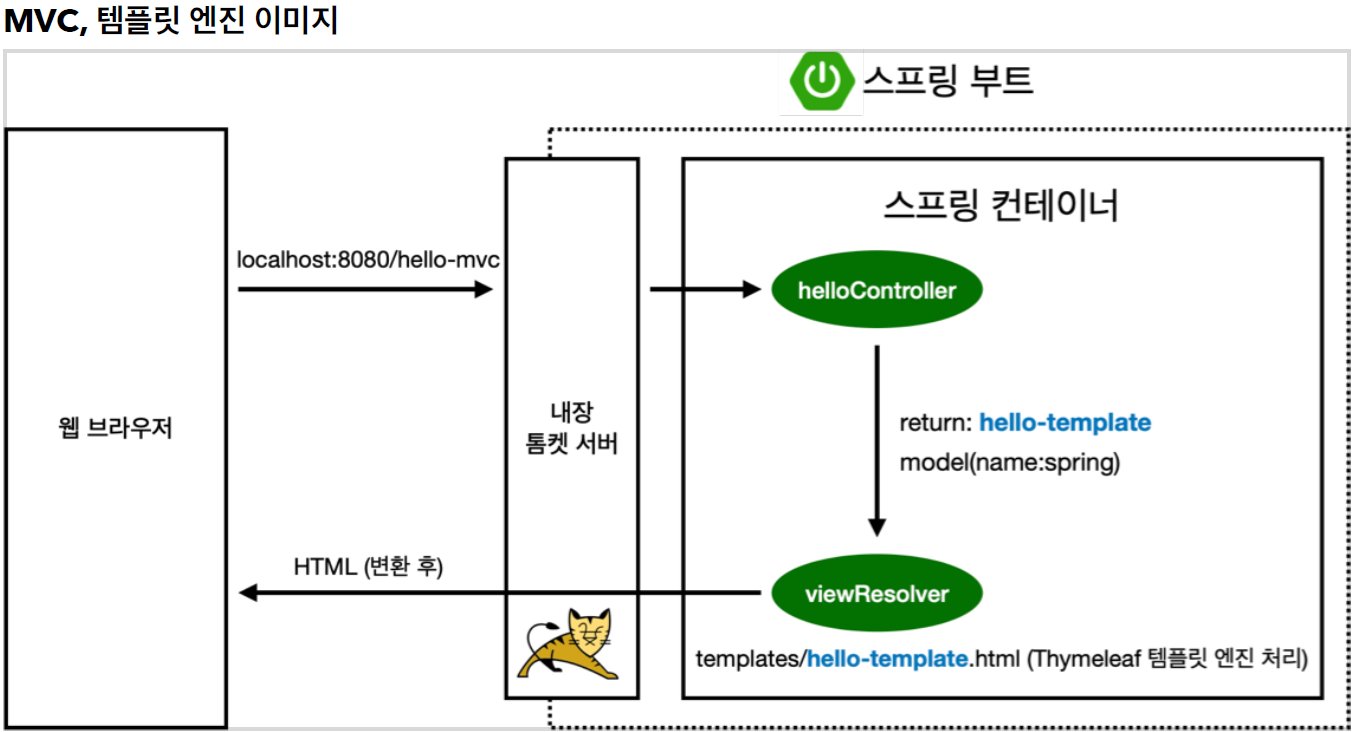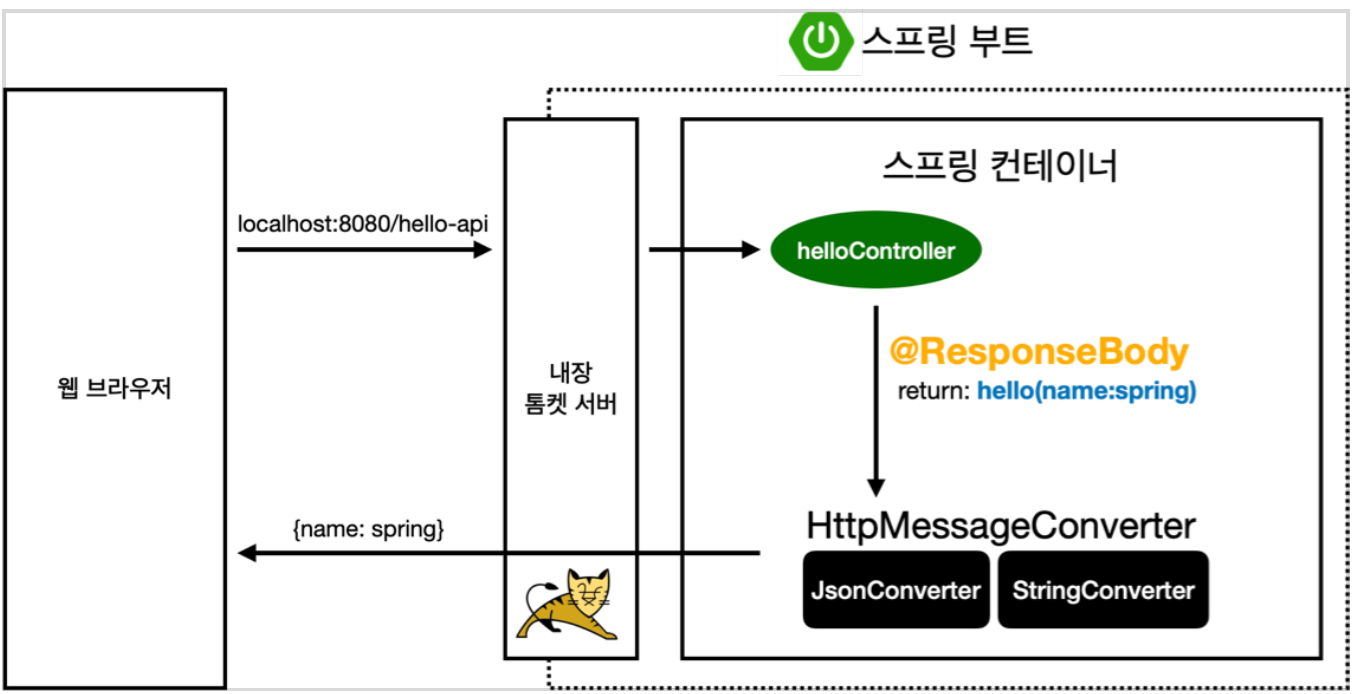- 정적 컨텐츠: 파일을 그대로 줌
- MVC와 템플릿 엔진: 템플릿 엔진은 서버에서 프로그래밍해서
html을 동적으로 바꾸어서내려주는 것 - API: JSON 데이터 포맷으로 클라이언트에게 데이터 전달 -> 화면은 클라이언트가 알아서
정적 컨텐츠
- 스프링부트는 정적 컨텐츠 기능을 제공한다.
- https://docs.spring.io/spring-boot/docs/2.3.1.RELEASE/reference/html/spring-boot-features.html#boot-features-spring-mvc-static-content
resources/static/hello-static.html
<!DOCTYPE HTML>
<html>
<head>
<title>static content</title>
<meta http-equiv="Content-Type" content="text/html; charset=UTF-8" />
</head>
<body>
정적 컨텐츠 입니다.
</body>
</html>실행: http://localhost:8080/hello-static.html
- 정적 파일 그대로 반환
- 프로그래밍을 할 수 없음

- 내장 톰캣 서버가 요청을 받고 스프링에게 넘김
- 컨트롤러에서 찾아봄 -> 없음
- 스프링부트가 resources: static에서 찾음
- 찾으면 반환
MVC와 템플릿 엔진
Model, View, Controller
- view: 화면을 그림
- controller: 비즈니스 로직, 내부적인 것들 처리
- model:
model에 화면에 필요한 것들 담아서 화면으로 넘김
Controller
@Controller
public class HelloController {
@GetMapping("hello-mvc")
public String helloMvc(@RequestParam("name") String name, Model model) {
model.addAttribute("name", name);
return "hello-template";
}
}@RequestParam("name")
- Parameter 속성 중 required의 default가 true이기 때문에 기본으로 값을 넘겨줘야 함
- required = false라면 값을 넘기지 않아도 됨
View
resources/template/hello-template.html
<html xmlns:th="http://www.thymeleaf.org">
<body>
<p th:text="'hello ' + ${name}">hello! empty</p>
</body>
</html><p th:text="'hello ' + ${name}">hello! empty</p>: th:text="'hello ' + ${name}" 안의 값으로hello! empty가 치환됨
hello! empty: 서버 없이 html을 만들어서 볼 때
실행: http://localhost:8080/hello-mvc?name=spring!

- 내장 톰캣 서버를 먼저 거침
- 톰캣 서버가 스프링에게 줌
- 스프링은
HelloController에서 매핑을 찾아 메소드 호출 - return 할 때 model도 같이 넘겨줌
- viewResolver가 동작함
- view를 찾고 템플릿 엔진에게 처리해 달라고 넘김
- 템플릿 엔진이 렌더링하고 변환한 html을 웹 브라우저에게 넘겨줌
API
@ResponseBody 문자 반환
@Controller
public class HelloController {
@GetMapping("hello-string")
@ResponseBody
public String helloString(@RequestParam("name") String name) {
return "hello" + name;
}
}@ResponseBody
@ResponseBody를 사용하면 뷰 리졸버(viewResolver)를 사용하지 않음 == view가 없음- 대신에 HTTP의 BODY에 문자 내용을 직접 반환
- http 메시지에는 header와 body가 있음
- body에 이 데이터를 직접 넣어줌
실행 : http://localhost:8080/hello-string?name=spring!!!
결과: hello spring!!!
페이지 소스에도 hello spring!!!만 있음
@ResponseBody 객체 반환
@Controller
public class HelloController {
@GetMapping("hello-api")
@ResponseBody
public Hello helloApi(@RequestParam("name") String name) {
Hello hello = new Hello();
hello.setName(name);
return hello;
}
static class Hello {
private String name;
public String getName() {
return name;
}
public void setName(String name) {
this.name = name;
}
}
}
- 객체를 반환하면 객체가 JSON으로 변환됨
내부 클래스는 static으로 선언해야 함
참고: Java의 내부 클래스는 static으로 선언하자
실행: http://localhost:8080/hello-api?name=spring??
결과: JSON (key-value로 이루어진 데이터 포맷)
{"name":"spring!!!"}
페이지 소스도 똑같이 {"name":"spring!!!"}
@ResponseBody 사용원리

- 톰캣 내장 서버가 hello-api가 왔어라고 스프링에게 넘겨줌
@ResponseBody가 있으면 HTTP의 BODY에 문자 내용을 직접 반환viewResolver대신에HttpMessageConverter가 동작- 문자가 아니라 객체라면? -> default는 JSON 방식으로 데이터를 만들어서 HTTP 응답에 반환
- 단순 문자:
StringHttpMessageConverter - 객체:
MappingJackson2HttpMessageConverter
Jackson: 객체를 JSON으로 바꾸는 라이브러리 - JSON을 웹 브라우저에 넘김
byte 처리 등등 기타 여러 HttpMessageConverter가 기본으로 등록되어 있다.
참고: 클라이언트의 HTTP Accept 헤더와 서버의 컨트롤러 반환 타입 정보 둘을 조합해서
HttpMessageConverter가 선택된다. 더 자세한 내용은 스프링 MVC 강의에서 설명하겠다.
- HTTP 요청을 할 때 Accept 헤더는 나는 데이터를 이런 포맷으로 받고 싶다는 내용
ex) xml, json ...